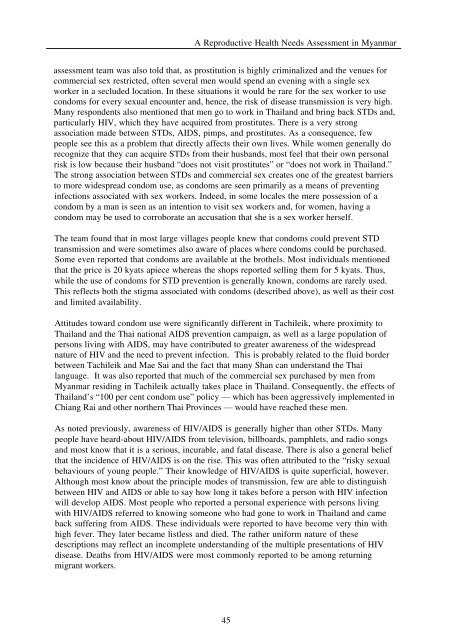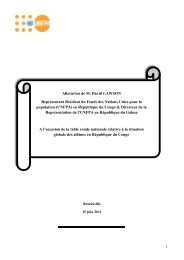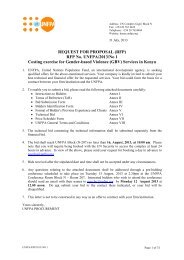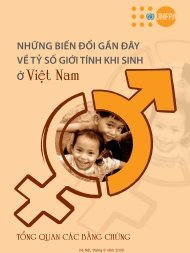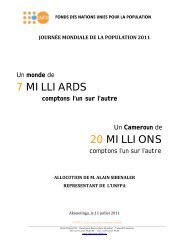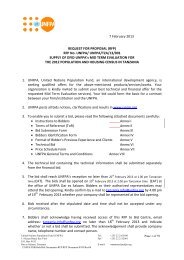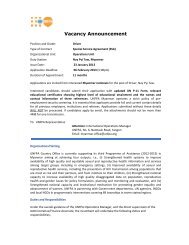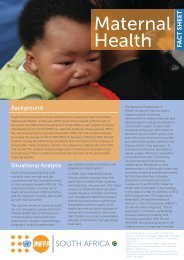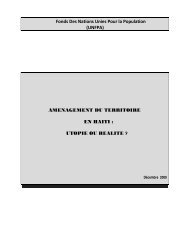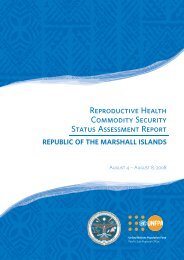A reproductive health needs assessment in Myanmar
A reproductive health needs assessment in Myanmar
A reproductive health needs assessment in Myanmar
Create successful ePaper yourself
Turn your PDF publications into a flip-book with our unique Google optimized e-Paper software.
A Reproductive Health Needs Assessment <strong>in</strong> <strong>Myanmar</strong><br />
<strong>assessment</strong> team was also told that, as prostitution is highly crim<strong>in</strong>alized and the venues for<br />
commercial sex restricted, often several men would spend an even<strong>in</strong>g with a s<strong>in</strong>gle sex<br />
worker <strong>in</strong> a secluded location. In these situations it would be rare for the sex worker to use<br />
condoms for every sexual encounter and, hence, the risk of disease transmission is very high.<br />
Many respondents also mentioned that men go to work <strong>in</strong> Thailand and br<strong>in</strong>g back STDs and,<br />
particularly HIV, which they have acquired from prostitutes. There is a very strong<br />
association made between STDs, AIDS, pimps, and prostitutes. As a consequence, few<br />
people see this as a problem that directly affects their own lives. While women generally do<br />
recognize that they can acquire STDs from their husbands, most feel that their own personal<br />
risk is low because their husband “does not visit prostitutes” or “does not work <strong>in</strong> Thailand.”<br />
The strong association between STDs and commercial sex creates one of the greatest barriers<br />
to more widespread condom use, as condoms are seen primarily as a means of prevent<strong>in</strong>g<br />
<strong>in</strong>fections associated with sex workers. Indeed, <strong>in</strong> some locales the mere possession of a<br />
condom by a man is seen as an <strong>in</strong>tention to visit sex workers and, for women, hav<strong>in</strong>g a<br />
condom may be used to corroborate an accusation that she is a sex worker herself.<br />
The team found that <strong>in</strong> most large villages people knew that condoms could prevent STD<br />
transmission and were sometimes also aware of places where condoms could be purchased.<br />
Some even reported that condoms are available at the brothels. Most <strong>in</strong>dividuals mentioned<br />
that the price is 20 kyats apiece whereas the shops reported sell<strong>in</strong>g them for 5 kyats. Thus,<br />
while the use of condoms for STD prevention is generally known, condoms are rarely used.<br />
This reflects both the stigma associated with condoms (described above), as well as their cost<br />
and limited availability.<br />
Attitudes toward condom use were significantly different <strong>in</strong> Tachileik, where proximity to<br />
Thailand and the Thai national AIDS prevention campaign, as well as a large population of<br />
persons liv<strong>in</strong>g with AIDS, may have contributed to greater awareness of the widespread<br />
nature of HIV and the need to prevent <strong>in</strong>fection. This is probably related to the fluid border<br />
between Tachileik and Mae Sai and the fact that many Shan can understand the Thai<br />
language. It was also reported that much of the commercial sex purchased by men from<br />
<strong>Myanmar</strong> resid<strong>in</strong>g <strong>in</strong> Tachileik actually takes place <strong>in</strong> Thailand. Consequently, the effects of<br />
Thailand’s “100 per cent condom use” policy — which has been aggressively implemented <strong>in</strong><br />
Chiang Rai and other northern Thai Prov<strong>in</strong>ces — would have reached these men.<br />
As noted previously, awareness of HIV/AIDS is generally higher than other STDs. Many<br />
people have heard-about HIV/AIDS from television, billboards, pamphlets, and radio songs<br />
and most know that it is a serious, <strong>in</strong>curable, and fatal disease. There is also a general belief<br />
that the <strong>in</strong>cidence of HIV/AIDS is on the rise. This was often attributed to the “risky sexual<br />
behaviours of young people.” Their knowledge of HIV/AIDS is quite superficial, however.<br />
Although most know about the pr<strong>in</strong>ciple modes of transmission, few are able to dist<strong>in</strong>guish<br />
between HIV and AIDS or able to say how long it takes before a person with HIV <strong>in</strong>fection<br />
will develop AIDS. Most people who reported a personal experience with persons liv<strong>in</strong>g<br />
with HIV/AIDS referred to know<strong>in</strong>g someone who had gone to work <strong>in</strong> Thailand and came<br />
back suffer<strong>in</strong>g from AIDS. These <strong>in</strong>dividuals were reported to have become very th<strong>in</strong> with<br />
high fever. They later became listless and died. The rather uniform nature of these<br />
descriptions may reflect an <strong>in</strong>complete understand<strong>in</strong>g of the multiple presentations of HIV<br />
disease. Deaths from HIV/AIDS were most commonly reported to be among return<strong>in</strong>g<br />
migrant workers.<br />
45


